COMMS # 62/1
 |
FECO:
|
COMMS
# 62/1 |
|
MODIFICATION NO:
|
N/A |
|
PRODUCT:
|
CHASE
IO-LINK-SOHO ISDN ROUTER |
|
SUB-ASSEMBLY:
|
N/A |
|
ESTIMATED MAN HOURS:
|
N/A |
|
CLASS OF CHANGE:
|
MANDATORY |
|
REASON FOR CHANGE:
|
REVISED
EDITION OF FECO |
|
RELATED FECO/AB
|
FECO
COMMS # 63, 64 & 65 |
CHASE IO-LINK-SOHO ISDN ONLY ROUTER
Revised edition of FECO. Replace FECO COMMS#62 with this FECO COMMS #
62/1
1 INTRODUCTION
1.1
This is to introduce the
Chase IO-LINK-SOHO, it is the Chase entry level ISDN Bridge Router.
There are two versions the IR and the BR.
They are the IO-LINK-SOHO-IR Internet Ready unit and the slightly more featured
IO-LINK-SOHO-BR Branch Router
1.2 The IR
version is designed for up to 10 users (10 IP Addresses), whilst the BR version has
unlimited users. Both units have the same bandwidth and throughput. They look identical
and the
only way to tell the difference is to enter the set-up menus and look for the IPX Set-up
facility. The
IR does not have this facility, the BR does.
Note it is possible to upgrade an IR to BR specification..
1.3 The SOHO
units are small, approx 4.5 in wide by 6in deep by 1.5in high; coloured black with four
LED’s in line across the front. See over.
1.4 The SOHO
has one LAN interface (MIDI & MIDIX) and one WAN interface. There is also the
console connection. All connections are RJ45.
1.5 The SOHO
will interface with other Chase products including the Chase IO-LINK-PRO, and the
IO-LINK-CENTRAL.
2
MEC IDENTITY
The MEC ID is CHASE-IOLINK-SOHO-IR and CHASE-IOLINK-SOHO-BR
3
CABLE SPECS see diagram on page 15
RJ45 connectors for the ISDN WAN, LAN & for the Console.
Console EDP Cable Type KJ.
WAN EDP Cable Type JF (MIDI)
LAN EDP Cable Type JF or JP (MIDIX).
4
FRONT
& REAR VIEWS


5
SOHO CONFIGURATION
5.1 Connect a
VDU set to 9600 8-1-N & VT100, to the Console Port with a Cable Type KJ.
5.2 Power on
the IOLINK-SOHO and view the Start-up Testing and Initialising Sequence on the VDU
Screen. At the prompt Press ENTER to access console, enter <CR>
5.3 At Enter
Terminal type: vt100 <CR>
At LOGIN MENU Select 1 Login
At Password prompt Enter BRIDGE <CR> This is case sensitive.
5.4 The MAIN MENU will be
displayed
Option
Value
Description
1. Quick Start
menu
2. Configuration menu
- Define operating parameters
3. Statistics
menu
- Device LAN and WAN statistics
4. Diagnostics
menu
- Access troubleshooting tools
5. Network events menu
- View network event history
6. Save configuration
- Save configuration immediately
7. Logout
-
End operator session
8. Help
-
Read menu introduction
5.5 All
configurations are menu driven
5.6 To Clear A
Lost Password
5.6.1 Remove the power from the
SOHO.
5.6.2
Remove the case cover.
5.6.3
Remove the Jumper Strap on pins 3-6
OF W1, see diagram over.
5.6.4
Re-attach the power to the SOHO and
wait for the Power LED to go Green.
5.6.5
Remove the power from the SOHO.
5.6.6
Replace the case cover.
5.6.7
Power up the SOHO.
5.6.8
Log into the SOHO as per para 5.4
above using the Password BRIDGE.
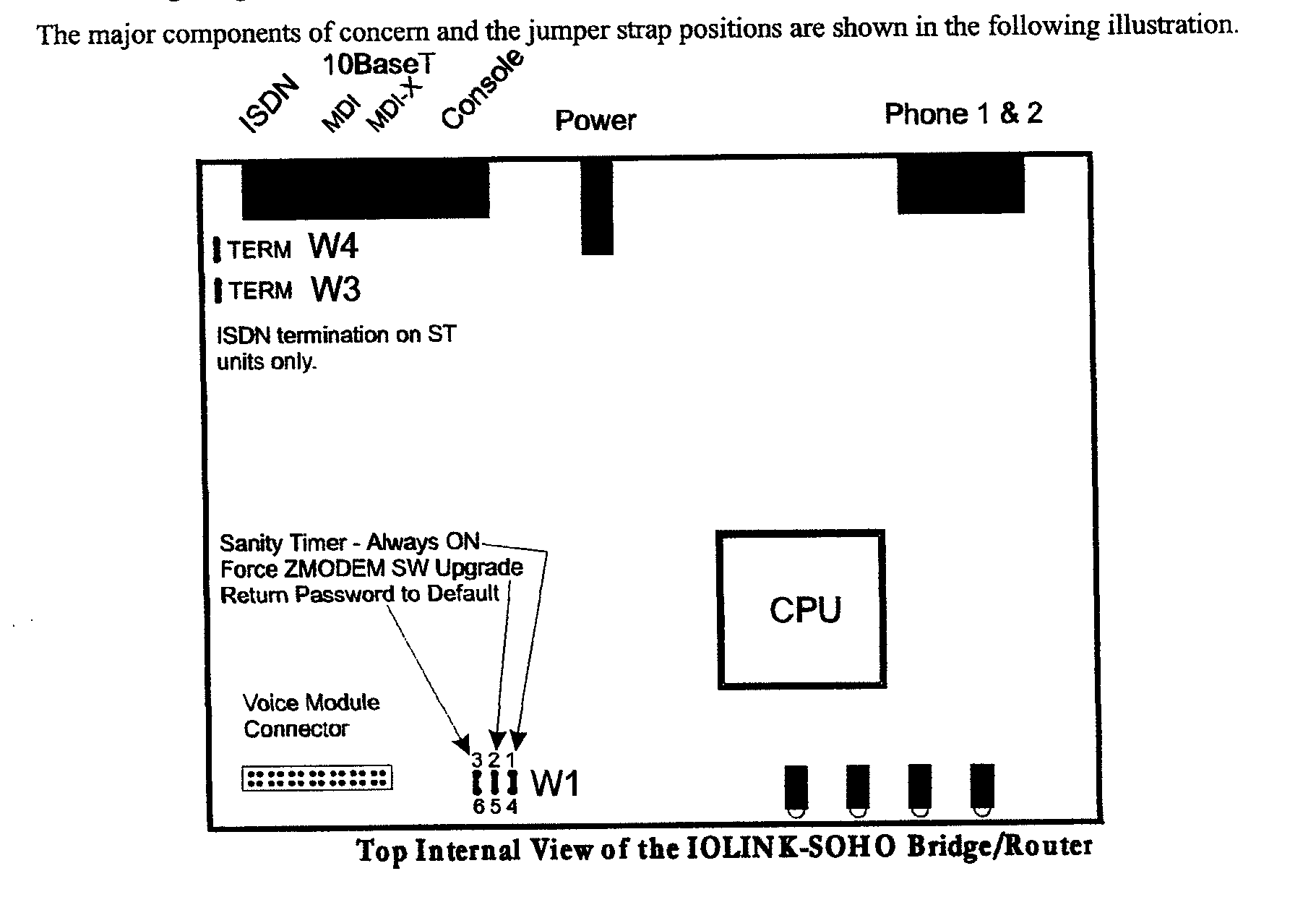
6
CONVENTIONS USED
6.1 The Menu
System is in the form of a tree shown over.
To go forwards through the Menu System Enter the Option Number required, usually you do
not
need to follow this with a <CR>.
6.2 To select an
option enter the Option number and enter the required input. If the input is fixed
options, then these will be displayed; just enter enough of the characters for it to be
unique. i.e. jun
for june, but only d for december. For options like IP addresses they must be entered in
full.
Most entries require a <CR> to terminate data input. Any entry that is not
acceptable , like an out
of range IP Address, will be identified as unacceptable and you will be invited to try
again.
To toggle between two options e.g. enabled and disabled, just enter the option number,
and it
will prompt "yes" to enable/disable parameter. Enter yes <CR>
to complete the toggle.
6.3 To go backwards
through the Menu System use the TAB key.
To return to the Main Menu Enter =
6.4 At the end of
each sequence it is advisable to save the configuration , From the Main Menu select
the option Save configuration. When completed Configuration saved will be
displayed at the
bottom of the screen.
On completion of all set-ups Save configuration and also carry out a soft reset,
from the Main
Menu select Diagnostics and then Soft reset.
6.5 A Soft reset
can be used to reset some minor problems.
6.6 NOTE, there
may be some variation in menus and the menu numbers between different
units, which is why the set-up procedures do not give the numbers, but do give the
option description.
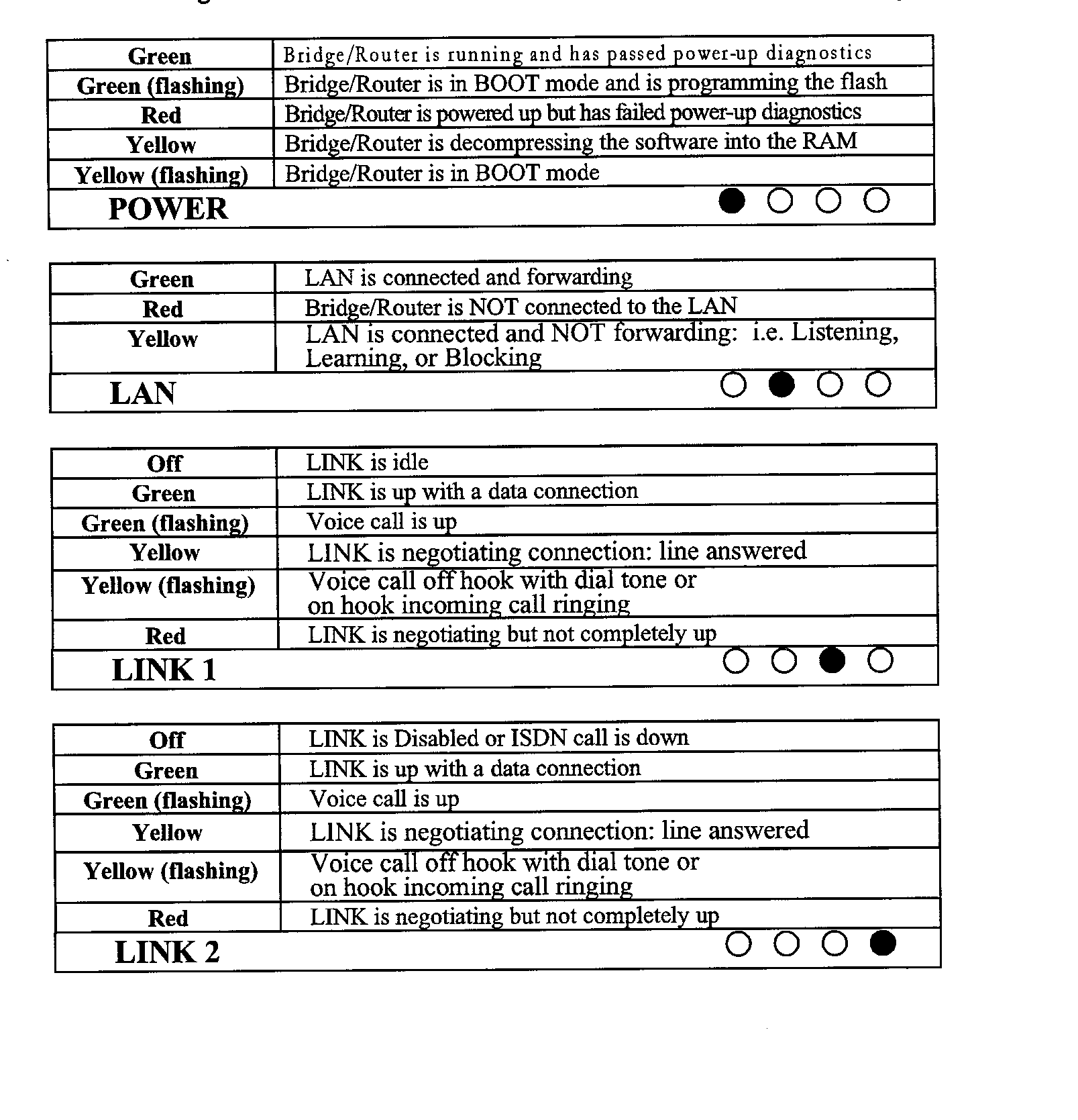
7 REQUIREMENTS
Before a SOHO can be configured the following must be available:-
Network diagram of the complete network
Name (preferrably geographical ie.HULL) of both Routers.
IP Address and Subnet Mask of both Routers.
ISDN number of both Routers.
Type of ISDN line.
Type of Routing Protocol, which MUST be the same at both ends.
{The Routing Protocol is especially important where the device at the other end is
not a Chase 130, if the Protocols are not harmonised then the link will not work.
The usual options are rip2 or None + static routes]
For Optional Customer Preference settings:-
PAP, CHAP Passwords.
Source/Destination IP Addresses of the frames.
Firewalls, only setup a Firewall if it is required. If required then the optional settings
of the Firewall MUST be determined during the Site Survey and documented
BEFORE the Configuration & Installation.
8
DEFAULT
For a new IOLINK-SOHO it is advisable to reset to the factory default settings:
From the Main Menu Select Diagnostics
From the Diagnostics Menu Select Full Reset.
After a Full Reset you will be prompted for the Terminal Type, Enter vt100
<CR>
9
PART OF MENU TREE
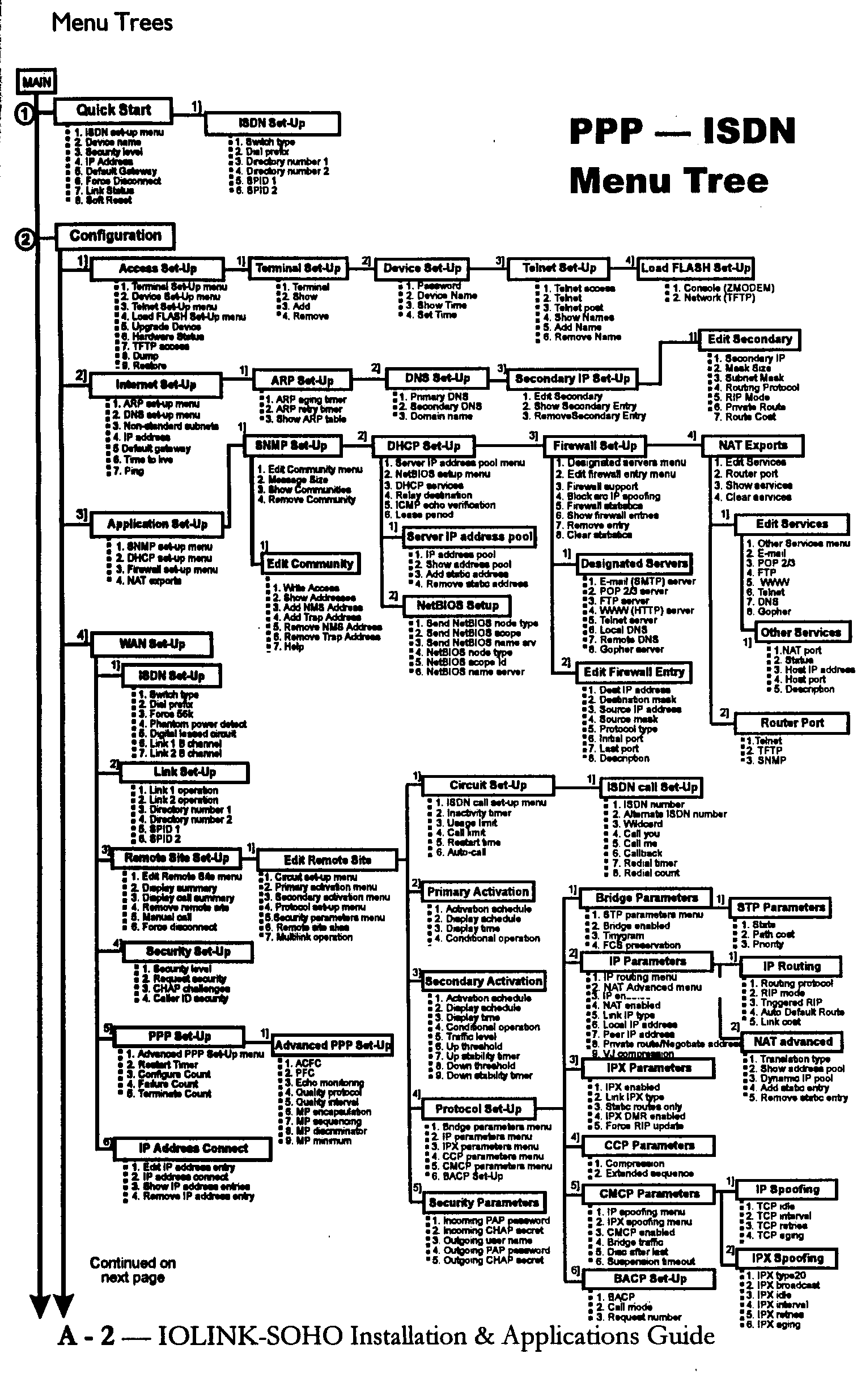
10 A typical network
is shown at the end of the FECO, and it can be easier to identify sites by their
geographical names.
The convention used is to nominate one site as the MAIN and the other as the REMOTE.
There
are differences in their configurations.
Each site will probably be different, but a sample configuration is detailed below.
11 TYPICAL
SET-UP FOR THE NETWORK DIAGRAM SHOWN is detailed below. NOTE.
For ANY other network there may, sorry WILL, be differences.
MAIN SOHO (LONDON Site ) Set-up
11.1 It is always best to reset the
factory default settings before a new configuration is set.
If the unit has been set-up before, you may wish to record the settings before wiping it.
TO RESET TO FACTORY SETTINGS:
From the Main Menu Select Diagnostics
From the Diagnostics Menu Select Full Reset yes <CR>
After a Full Reset you will be prompted for the Terminal Type, Enter vt100 <CR>
11.2 The MAIN MENU
Option
Value
Description
1. Quick Start
menu
2. Configuration
menu
- Define operating parameters
3. Statistics
menu
- Device LAN and WAN statistics
4. Diagnostics
menu
- Access troubleshooting tools
5. Network events
menu
- View network event history
6. Save configuration
- Save configuration immediately
7. Logout
- End operator session
8. Help
- Read menu introduction
11.3 Set Local Parameters
from the Main Menu select Configuration
select Access set-up
select device set-up
select Device name and type in router name e.g. LONDON <CR>
select Set time type in using yyyy-mm-dd format
type in using hh:mm:ss format
select Show time to confirm current time and date settings are correct.
TAB back to the previous menu.
select TFTP access and toggle it to enabled.
TAB back to the previous menu.
select LAN set-up
select Bridge set-up and toggle it to disabled by typing in yes at
prompt
TAB back to the previous menu.
select IP set-up
select IP address and Enter the address of the unit e.g. 192.1.1.10 <CR>
when prompted to Enter the subnet mask e.g. 24 <CR>
Examples of subnet masks are:-
8 255.0.0.0
16 255.255.0.0
24 255.255.255.0
select Routing protocol and type in none <CR>
TAB and TAB again.
select Bridging set-up
select Bridge forwarding type in yes at the prompt to toggle it to disabled
TAB back to the previous menu.
For a BR SOHO IPX routing must be disabled [ see below ] an IR
SOHO doesn’t have this
option.
select IPX routing set-up
Select IPX routing type in yes at the prompt to toggle it to disabled
Type in = to
return to the Main menu
11.4 ISDN set-up
from Main Menu select Configuration
select WAN set-up
select Remote site set-up
select Remote site summary can be used to show existing set-ups
Note ISDN_TEMPLATE ID = 41
select Edit remote site Enter name of remote site e.g. DERBY <CR>
Enter: Template Id or alias ( or none ) 41 <CR>
Ensure that this name is now displayed in the Remote site alias
select Connection set-up
select ISDN call set-up
select ISDN number and Enter the ISDN no of the remote site [2222]
<CR>
TAB to the previous menu.
check Auto-call is set to disabled
and TAB again
11.5 Optional setting Customer Usage
restricting number and/or length of calls.
from Edit remote circuit set-up Menu
select Activation set-up
select Inactivity timer reduce to 20 secs [default = 60]
<CR>
select Usage set-up
set Usage and/or Call limit, and Restart time if required.
TAB and TAB
11.6 Disable Bridge and IPX
from Edit Remote Site 1 Menu
[ Enter Remote Site id = DERBY if asked ]
select Protocol set-up
select Bridge parameters
select Bridge enabled and toggle it to disabled TAB
select IPX parameters (BR only)
select IPX enabled and toggle it to disabled (BR only )
TAB and TAB again.
11.7 Remote Protocol set-up
from Edit Remote
Site Protocol Set-Up
select IP parameters
select IP routing
select Routing protocol and set it to none
select Triggered RIP and set it to disabled
[ Note for
rip2 protocol the Triggered RIP setting needs to be link_up_only ].
TAB
check IP enabled
is enabled, NAT is disabled and Link IP type is unnumbered.
TAB
select Multilink protocol and toggle it to disabled
TAB
select Connection and type in single_link <CR>
select Remote site type and set it to spoofing
TAB again
from Remote Site
Set Up Menu
select Remote site summary and check all the entries are correct.
Type in = to return to the Main
menu
11.8 from Main Menu select Configuration
select WAN set-up
select IP address connect
select IP address connect and toggle it to enabled.
select Edit IP address entry
set the IP address connect entry Id = 1 <CR>
and Enter the IP address of the remote network e.g. 128.10.0.0 <CR>
when prompted to Enter the subnet mask e.g. 16 <CR>
Remote site alias or id = DERBY <CR>
select Show IP address entries
This displays something similar to below:
ID IP ADDRESS
SUBNET MASK SIZE SUBNET MASK REMOTE SITE
1
128.10.0.0
16
255.255.0.0 DERBY
Type in = to
return to the Main menu
from Main Menu
select Configuration
select IP routing set-up
select IP routes
select Edit route
select Destination
at IP
addr enter the Remote IP Network e.g. 128.10.0.0
at mask size
enter Network mask e.g. 16 <CR> ( for 255.255.0.0 )
select Next hop and enter the remote site ID or alias e.g. DERBY <CR>
check all details
displayed are correct – note Status – if present this route exists.
If absent add
it to the table using Add option.
TAB
select Show all routes and check that the routing information is correct.
Type in = to return to the Main
menu
select Save configuration
11.9 Product the Configuration Record, and distribute i.a.w. AB198.
12 Optional Security
Before implementing
Optional Security, test the link thoroughly.
13 Optional Security set-up
13.1 To set PAP or CHAP only set items required.
from WAN Set-Up menu
select Remote site set-up
select Edit remote site
enter Remote site id or alias e.g. [ DERBY ]
select Connection set-up ?
select Security parameters
select Incoming PAP password and enter DERBY ( remote site name )
check Outgoing user name is LONDON ( local site name )
select Outgoing PAP password and enter LONDON (local site name )
TAB, TAB and TAB again.
13.2 select WAN
set-up
select Security set-up
select Security level and enter PAP
select Request security and enter always
check CHAP challenges is set to once
select Caller ID security and toggle it to disabled
Type in = to return to the Main menu
13.3 select Save
configuration
Note changes made here will not take effect until the link is disabled and re-enabled
13.4 After implementing Optional Security,
test the link thoroughly.
13.5 Produce the Configuration Record, and
distribute i.a.w. AB198.
14 Optional Firewall
setup
14.1 Only set items required.
14.2 from Configuration menu select Applications
set-up
select Firewall set-up
select WAN firewall set-up enter Remote site number or alias e.g. DERBY
select Firewall and enter inbound, outbound, both, or disabled
14.3 from Remote Site Firewall Menu
select Designated servers and the following menu will be displayed
Option
Value
Description
1. E-mail (SMTP) server
none - Specify
E-Mail server IP address
2. POP 2/3 server
none - Specify
E-Mail server IP address
3. FTP server
none - Specify FTP
server IP address
4. WWW (HTTP) server
none - Specify
WWW server IP address
5. Telnet server
none - Specify
Telnet server IP address
6. Local DNS
none - Specify
local DNS IP address
7. Remote DNS
none - Specify
remote DNS IP address
8. Secondary local DNS none
- Specify local
DNS IP address
9. Secondary remote DNS none
- Specify remote
DNS IP address
Set the required parameters
14.4 TAB and TAB again
14.5 from Firewall set-up menu select LAN
firewall setup
select Firewall and enter inbound, outbound, both, or disabled
14.6 from Firewall LAN menu select Edit firewall entry
and the following
menu will be displayed, showing sample entries
Option
Value
Description
1. Destination address
128.10.10.1 -
Destination IP address of frame
2. Destination mask
255.255.0.0 -
Network mask for dest address
3. Source address
192.1.1.1
- Source IP address of frame
4. Source mask
255.255.255.0
- Network mask for source address
5. Protocol type
TCP
- Allow Specific
protocol types
6. Source port
65535
- Source port range to
allow
7. Destination port
65535
- Destination port range to allow.
8. Description
- Describe the entry
9. Entry direction
- Direction this entry applies to
14.7 Set the required parameters
14.8 Note changes made here might not take
effect until the link is disabled and re-enabled
14.9 Type in = to return to the Main menu
select Save configuration
14.10 Produce the Configuration Record, and distribute
i.a.w. AB198.
15 REMOTE SOHO
(DERBY Site) Set-up
15.1 TO RESET TO FACTORY SETTINGS:
From the Main Menu Select Diagnostics
From the Diagnostics Menu Select Full Reset.
After
a Full Reset you will be prompted for the Terminal Type, Enter vt100 <CR>
15.2 The MAIN MENU
Option
Value
Description
1. Quick Start
menu
2. Configuration menu
- Define operating
parameters
3. Statistics
menu
- Device LAN and WAN
statistics
4. Diagnostics menu
- Access
troubleshooting tools
5. Network events menu
- View network event
history
6. Save configuration
- Save configuration immediately
7. Logout
-
End operator session
8. Help
-
Read menu introduction
15.3 Set Local Parameters
from the Main Menu select Configuration
select Access set-up
select device set-up
select Device name and type in router name e.g. DERBY <CR>
select Set time type in using yyyy-mm-dd & hh:mm:ss format
select Show time to confirm current time and date settings are correct.
TAB back to the previous menu.
select TFTP access and toggle it to enabled.
TAB back to the previous menu.
select LAN set-up
select Bridge set-up and toggle it to disabled by typing in yes at
prompt
TAB back to the previous menu.
select IP set-up
select IP address and Enter the unit address e.g. 128.10.10.10 <CR>
when prompted to Enter the subnet mask e.g. 16 <CR>
Examples of subnet masks are:-
8 255.0.0.0
16 255.255.0.0
24 255.255.255.0
select Routing protocol and type in none <CR>
TAB and TAB again.
select Bridging set-up
select Bridge forwarding type in yes at the prompt to toggle it to disabled
TAB back to the previous menu.
For a BR SOHO IPX routing must be disabled [ see below ] an IR
SOHO doesn’t have this
option.
select IPX routing set-up
Select IPX routing type in yes at the prompt to toggle it to disabled
15.4 Type in = to return to the Main menu
15.5 ISDN set-up
from Main Menu select Configuration
select WAN set-up
select Remote site set-up
select Remote site summary can be used to show existing set-ups
Note ISDN_TEMPLATE ID = 41
select Edit remote site Enter name of remote site e.g. LONDON <CR>
Enter: Template Id or alias ( or none ) 41 <CR>
Ensure that this name is now displayed in the Remote site alias
select Connection set-up
select ISDN call set-up
select ISDN number and Enter the ISDN no of the remote site [1111]
<CR>
15.6 TAB to the previous menu.
check Auto-call is set to disabled
and TAB again
15.7 Optional setting
Customer Usage restricting number or length of calls.
from Edit remote circuit set-up Menu
select Activation set up
select Inactivity timer reduce to 20 seconds [default = 60] <CR>
select Usage set-up
set Usage and/or Call limit, and Restart time if required. TAB
15.8 TAB
15.9 Disable Bridge and IPX
from Edit Remote Site 1 Menu
[ Enter remote Site id = LONDON if asked ]
select Protocol set-up
select Bridge parameters
select Bridge enabled and toggle it to disabled
select IPX parameters (BR only)
select IPX enabled and toggle it to disabled (BR only)
TAB and TAB again.
15.10 Remote Protocol set-up
from Edit
Remote Site Protocol Set-Up
select IP parameters
select IP routing
select Routing protocol and set it to none
select Triggered RIP and set it to disabled
[ Note for rip2 protocol the Triggered RIP setting needs to be
link_up_only ].
TAB
check IP enabled is enabled, NAT is disabled and Link IP type is
unnumbered.
TAB
select Multilink protocol and toggle it to disabled
TAB
select Connection and type in single_link <CR>
select Remote site type and set it to spoofing
TAB again
from Remote Site Set Up Menu
select Remote site summary and check all the entries are correct.
15.11 Type in = to return to the Main menu
15.12 from Main Menu select Configuration
select Wan set-up
select IP address connect
select IP address connect and toggle it to enabled.
select Edit IP address entry
select the IP address connect entry Id = 1 <CR>
and Enter the IP address of the Main Site ( LONDON ) network e.g. 192.1.1.0
<CR>
when prompted to Enter the subnet mask e.g. 24 <CR>
Remote site alias or id = LONDON <CR>
select Show Ip address entries
This displays something similar to below:
ID IP Address Subnet Mask Size Subnet Mask Remote
Site
1 192.1.1.0
24
255.255.255.0 LONDON
Type in = to
return to the Main menu
from Main Menu select Configuration
select IP routing set-up
select IP routes
select Edit route
select Destination
at IP addr enter the Remote Ip Network e.g. 192.1.1.0
at mask size enter Network mask e.g. 24 <CR> ( for 255.255.255.0 )
select Next hop and enter the remote site ID or alias e.g. LONDON <CR>
check all details displayed are correct – note Status – if present this
route exists.
If absent add it to the table using Add option.
TAB
select Show all routes and check that the routing information is correct.
Type in = to
return to the Main menu
select Save configuration
select Save configuration
15.13 Produce the Configuration Record, and distribute
i.a.w. AB198.
16 Optional
Security
16.1 Before implementing Optional Security,
test the link thoroughly.
17 Optional Security
set-up
17.1 To set PAP or CHAP only set items
required.
17.2 from WAN Set-Up menu select Remote
site set-up
select Edit remote site
enter Remote site id or alias e.g. [ LONDON ]
select Connection set-up ?
select Security parameters
select Incoming PAP password and enter LONDON ( remote site name )
check Outgoing user name is DERBY ( local site name )
select Outgoing PAP password and enter DERBY (local site name )
17.3 TAB, TAB and TAB again.
17.4 select WAN set-up
select Security set-up
select Security level and enter PAP
select Request security and enter always
check CHAP challenges is set to once
select Caller ID security and toggle it to disabled
17.5 Type in = to return to
the Main menu
select Save configuration
17.6 Note changes made here will not take effect until the link is
disabled and re-enabled.
17.7 After implementing Optional Security, test the link thoroughly.
17.8 Produce the Configuration Record, and distribute i.a.w. AB198.
18 Optional Firewall setup.
See para 14
Only set items
required.
Finally produce the
Configuration Record, and distribute i.a.w. AB198.
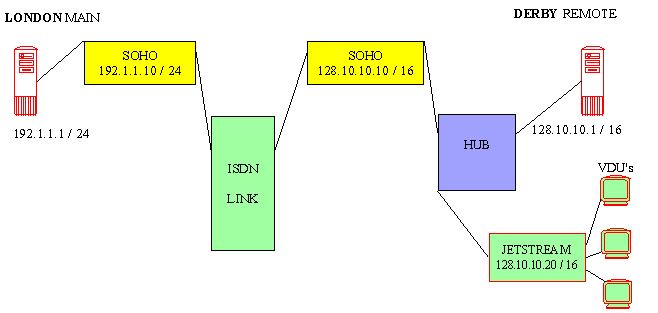
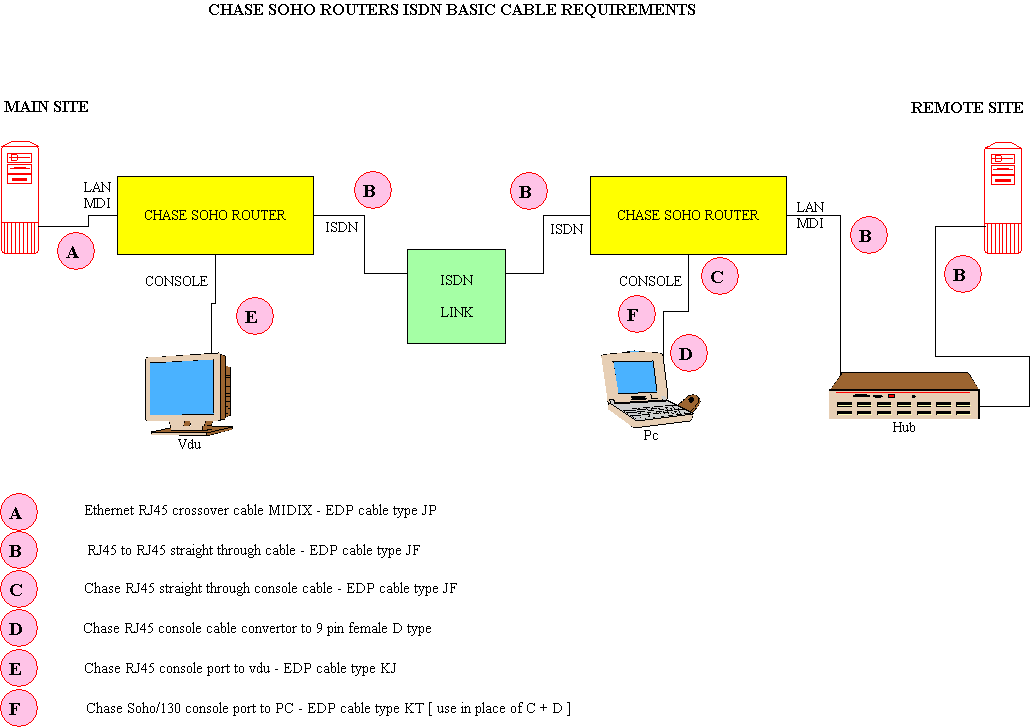
Return to
Index







